A Review on Traditional Processes and Laser Powder Bed Fusion of Aluminum Alloy Microstructures, Mechanical Properties, Costs, and Applications
Abstract
1. Introduction
2. Research Status of Traditional Manufacturing Processes for Aluminum Alloy
2.1. Traditional Aluminum Alloy Grades
2.2. Traditional Processes, Mechanical Properties, and Applications
2.3. Cost of Traditional Aluminum Alloy Manufacturing Processes
3. Research Status of LPBF Process for Aluminum Alloy
3.1. Defects and Microstructures
3.2. Mechanical Properties
| Materials | Process | Heat Treatment | Modulus GPa | UTS MPa | Strain % | Ref. |
|---|---|---|---|---|---|---|
| AlSi10Mg | LPBF | As-fabricated | 68 ± 3 | 396 ± 8 | 3.47 ± 0.6 | [112] |
| T6 | 66 ± 5 | 399 ± 7 | / | |||
| As-fabricated | 70.2 ± 1.2 | 267 | 9.1 ± 0.5 | [26] | ||
| As-fabricated | / | 367.7 | 4 | [113] | ||
| As-fabricated | / | 473 | 7.5 | [114] | ||
| 160 °C/4 h | / | 493 | 8.6 | [115] | ||
| 540 °C/1 h +160 °C/4 h | / | 323 | 15.3 | |||
| 450 °C/2 h | / | 282.4 ± 6.1 | 13.4 ± 0.5 | [116] | ||
| AlSi7Mg | LPBF | As-fabricated | / | 475.8 | 6.4 | [92] |
| AlSi12 | LPBF | As-fabricated | / | 418.9 ± 9.3 | 3.91 ± 0.3 | [117] |
| 240 °C | / | 369.3 ± 3.4 | 4.38 ± 0.16 | |||
| As-fabricated | / | 425.1 ± 24.7 | 12.1 ± 2.2 | [118] | ||
| 2 h solution | / | 190 | 25 | [119] | ||
| As-fabricated | / | 325 ± 20 | 4.4 ± 0.7 | [79] | ||
| 300 °C/6 h | / | 228 ± 13 | 5.3 ± 0.7 | |||
| A357 | LPBF | As-fabricated | / | 398 ± 13 | 7.6 ± 1.8 | [94] |
| 160 °C/4 h | / | 411 ± 10 | 4.8 ± 0.8 | |||
| 7075 + Zr | LPBF | T6 | 63~66 | 383~417 | 3.8~5.4 | [88] |
| AlZn5.43Mg2.65Cu1.4 + Si + TiB2 | LPBF | T6 | / | 566 ± 12 | 4.5 ± 1.1 | [90] |
| AlZn5.1Mg1.9Cu1.47 Si2.9Zr1.0 | LPBF | As-fabricated | / | 446 | 6.5 | [120] |
| AlZn7.0Mg3.0Cu1.0 Si2.9Zr1.0 | LPBF | As-fabricated | / | 421 | 6.7 | [89] |
| AlMg4.7Sc0.7Zr0.3 | LPBF | As-fabricated | / | 390 ± 2 | 24.9 ± 0.6 | [91] |
| 325 °C/4 h | / | 531 ± 2 | 15.0 ± 0.3 | |||
| A357 + 0.2Er | LPBF | As-fabricated | / | 441.3 ± 6.7 | 8 ± 1 | [103] |
| AlMn2.51Mg2.7Sc0.55 Cu0.29Zn0.31 | LPBF | As-fabricated | / | 350 | 10 | [121] |
| 325 °C/2 h | / | 440 | 9 |
3.3. Cost of Aluminum Alloy LPBF Processes
- Equipment
- 2.
- Raw materials
- 3.
- Energy consumption
- 4.
- Post-processing
- 5.
- Forming efficiency
3.4. Applications
4. Summary and Future Development Trends
4.1. Developing Aluminum Matrix Composite Materials Reinforced with Nanoceramic Particles
4.2. Developing Micro-Alloyed Aluminum Alloy Powders Specifically Designed for LPBF
4.3. Developing New Technology and Equipment to Reduce the Costs of LPBF
Funding
Institutional Review Board Statement
Informed Consent Statement
Data Availability Statement
Conflicts of Interest
References
- Wang, Z.; Oliveira, J.P.; Zeng, Z.; Bu, X.; Peng, B.; Shao, X. Laser beam oscillating welding of 5A06 aluminum alloys: Microstructure, porosity and mechanical properties. Opt. Laser Technol. 2019, 111, 58–65. [Google Scholar] [CrossRef]
- You, S.; Huang, Y.; Kainer, K.U.; Hort, N. Recent research and developments on wrought magnesium alloys. J. Magnes. Alloys 2017, 5, 239–253. [Google Scholar] [CrossRef]
- Hirsch, J.; Al-Samman, T. Superior light metals by texture engineering: Optimized aluminum and magnesium alloys for automotive applications. Acta Mater. 2013, 61, 818–843. [Google Scholar] [CrossRef]
- Azarniya, A.; Hosseini, H.R.M.; Jafari, M.; Bagheri, N. Thermal decomposition of nanostructured Aluminum Titanate in an active Al matrix: A novel approach to fabrication of in situ Al/Al2O3–Al3Ti composites. Mater. Des. 2015, 88, 932–941. [Google Scholar] [CrossRef]
- Dursun, T.; Soutis, C. Recent developments in advanced aircraft aluminium alloys. Mater. Des. 2014, 56, 862–871. [Google Scholar] [CrossRef]
- Wan, T.; Liu, Y.; Zhou, C.; Chen, X.; Li, Y. Fabrication, properties, and applications of open-cell aluminum foams: A review. J. Mater. Sci. Technol. 2021, 62, 11–24. [Google Scholar] [CrossRef]
- Wu, P.; Wu, S.; Sun, D.; Tang, Y.; Wang, H. A review of Al alloy anodes for Al–Air batteries in neutral and alkaline aqueous electrolytes. Acta Met. Sin. 2020, 34, 309–320. [Google Scholar] [CrossRef]
- Strauß, H. AM Envelope—The Potential of Additive Manufacturing for Façade Construction; Delft University of Technology: Delft, The Netherlands, 2013; pp. 225–235. [Google Scholar]
- Elia, G.A.; Kravchyk, K.V.; Kovalenko, M.V.; Chacón, J.; Holland, A.; Wills, R.G. An overview and prospective on Al and Al-ion battery technologies. J. Power Sources 2020, 481, 228870. [Google Scholar] [CrossRef]
- Ngo, T.D.; Kashani, A.; Imbalzano, G.; Nguyen, K.T.Q.; Hui, D. Additive manufacturing (3D printing): A review of materials, methods, applications and challenges. Compos. Part B Eng. 2018, 143, 172–196. [Google Scholar] [CrossRef]
- Murphy, S.V.; Atala, A. 3D bioprinting of tissues and organs. Nat. Biotechnol. 2014, 32, 773–785. [Google Scholar] [CrossRef]
- Frazier, W.E. Metal additive manufacturing: A Review. J. Mater. Eng. Perform. 2014, 23, 1917–1928. [Google Scholar] [CrossRef]
- Herzog, D.; Seyda, V.; Wycisk, E.; Emmelmann, C. Additive manufacturing of metals. Acta Mater. 2016, 117, 371–392. [Google Scholar] [CrossRef]
- Ligon, S.C.; Liska, R.; Stampfl, J.; Gurr, M.; Mülhaupt, R. Polymers for 3D Printing and Customized Additive Manufacturing. Chem. Rev. 2017, 117, 10212–10290. [Google Scholar] [CrossRef] [PubMed]
- Wang, Y.M.; Voisin, T.; McKeown, J.T.; Ye, J.; Calta, N.P.; Li, Z.; Zeng, Z.; Zhang, Y.; Chen, W.; Roehling, T.T.; et al. Additively manufactured hierarchical stainless steels with high strength and ductility. Nat. Mater. 2017, 17, 63–71. [Google Scholar] [CrossRef] [PubMed]
- Sames, W.J.; List, F.A.; Pannala, S.; Dehoff, R.R.; Babu, S.S. The metallurgy and processing science of metal additive manufacturing. Int. Mater. Rev. 2016, 61, 315–360. [Google Scholar] [CrossRef]
- Wang, X.; Xu, S.; Zhou, S.; Xu, W.; Leary, M.; Choong, P.; Qian, M.; Brandt, M.; Xie, Y.M. Topological design and additive manufacturing of porous metals for bone scaffolds and orthopaedic implants: A review. Biomaterials 2016, 83, 127–141. [Google Scholar] [CrossRef]
- Wang, X.; Li, A.; Liu, X. Fabrication of orientated micro porous metals: Control the melting process of powders by high scanning speed—Ultra short hatch spacing scanning strategy. Mater. Lett. 2023, 335, 133741. [Google Scholar] [CrossRef]
- Stansbury, J.W.; Idacavage, M.J. 3D printing with polymers: Challenges among expanding options and opportunities. Dent. Mater. 2016, 32, 54–64. [Google Scholar] [CrossRef] [PubMed]
- Gu, D.; Shi, X.; Poprawe, R.; Bourell, D.L.; Setchi, R.; Zhu, J. Material-structure-performance integrated laser-metal additive manufacturing. Science 2021, 372, eabg1487. [Google Scholar] [CrossRef]
- Wang, X.; Zhang, D.; Li, A.; Li, T.; Zhang, W.; Liu, X. Mechanical properties of hierarchical porous lattices with microscopic porosity fabricated by combination of lattice design and HSSH process. J. Manuf. Process. 2024, 118, 261–268. [Google Scholar] [CrossRef]
- Wang, X.; Li, A.; Liu, X.; Wan, X. Thermal Insulation and Compressive Performances of 3D Printing Flexible Load-Bearing and Thermal Insulation Integrated Lattice. Materials 2022, 15, 8625. [Google Scholar] [CrossRef] [PubMed]
- Du, L.; Ke, L.; Xiao, M.; Dou, E.; Luo, Z.; Chen, Y.; Lai, C. Densification, microstructure and properties of Sc and Zr modified Al-Mn alloy prepared by selective laser melting. Opt. Laser Technol. 2021, 148, 107703. [Google Scholar] [CrossRef]
- Spierings, A.; Dawson, K.; Kern, K.; Palm, F.; Wegener, K. SLM-processed Sc- and Zr- modified Al-Mg alloy: Mechanical properties and microstructural effects of heat treatment. Mater. Sci. Eng. A 2017, 701, 264–273. [Google Scholar] [CrossRef]
- Liu, D.; Wu, D.; Ge, C.; Lu, H.; Chen, Z.; Liu, M.; Wang, Y.; Niu, F.; Ma, G.; Luo, K.; et al. Superior strength of laser-arc hybrid additive manufactured Al-Zn-Mg-Cu alloy enabled by a tunable microstructure. Addit. Manuf. 2023, 68, 103526. [Google Scholar] [CrossRef]
- Rosenthal, I.; Stern, A.; Frage, N. Microstructure and mechanical properties of AlSi10Mg parts produced by the laser beam additive manufacturing (AM) technology. Met. Microstruct. Anal. 2014, 3, 448–453. [Google Scholar] [CrossRef]
- Chang, K.; Liang, E.Q.; Zhang, R.; Zheng, M.; Wei, L.; Huang, W.J.; Lin, X. Status of metal additive manufacturing and its application research in the field of civil aviation. Mater. Rep. 2021, 35, 3176–3182. [Google Scholar]
- Yan, L.; Chen, S.; Jiyi, Z. A review of wire arc additive manufacturing from aspects of physical process, research status, application situation and development trend. Weld. Join. 2020, 9, 31–37+63. [Google Scholar]
- Kenevisi, M.S.; Yu, Y.; Lin, F. A review on additive manufacturing of Al-Cu (2xxx) aluminium alloys, processes and defects. Mater. Sci. Technol. 2021, 37, 805–829. [Google Scholar] [CrossRef]
- Zhang, J.; Song, B.; Wei, Q.; Bourell, D.; Shi, Y. A review of selective laser melting of aluminum alloys: Processing, microstructure, property and developing trends. J. Mater. Sci. Technol. 2018, 35, 270–284. [Google Scholar] [CrossRef]
- GB/T 3190-2020; Chemical Composition of Wrought Aluminium and Aluminium Alloys. Standards Press of China: Beijing, China, 2021.
- Zhang, J.B.; Zhang, Y.A.; Zhu, B.H.; Liu, R.Q.; Wang, F.; Liang, Q.M. Characterization of microstructure and mechanical properties of Al–Cu–Mg–Ag–(Mn/Zr) alloy with high Cu: Mg. Mater. Des. 2013, 49, 311–317. [Google Scholar] [CrossRef]
- Babutskyi, A.; Mohin, M.; Chrysanthou, A.; Xu, Y.; Lewis, A. Effect of electropulsing on the fatigue resistance of aluminium alloy 2014-T6. Mater. Sci. Eng. A 2020, 772, 138679. [Google Scholar] [CrossRef]
- Arif, M.A.M.; Omar, M.Z.; Sajuri, Z.; Salleh, M.S. Effects of Cu and Mg on thixoformability and mechanical properties of aluminium alloy 2014. Trans. Nonferrous Met. Soc. China 2020, 30, 275–287. [Google Scholar] [CrossRef]
- Guo, N.; Wu, D.; Wang, G.; Cheng, Q.; Fu, Y.; Yu, M. Investigation on underwater wire-feed laser deposition of 5052 aluminum alloy. J. Manuf. Process. 2022, 76, 687–694. [Google Scholar] [CrossRef]
- Guan, F.; Duan, J.; Zhai, X.; Wang, N.; Zhang, J.; Lu, D.; Hou, B. Interaction between sulfate-reducing bacteria and aluminum alloys-Corrosion mechanisms of 5052 and Al-Zn-In-Cd aluminum alloys. J. Mater. Sci. Technol. 2020, 36, 55–64. [Google Scholar] [CrossRef]
- Moustafa, E.B.; Mosleh, A.O. Effect of (Ti–B) modifier elements and FSP on 5052 aluminum alloy. J. Alloys Compd. 2020, 823, 153745. [Google Scholar] [CrossRef]
- Luo, D.; Li, F.; Xing, G. Corrosion resistance of 6061-T6 aluminium alloy and its feasibility of near-surface reinforcements in concrete structure. Rev. Adv. Mater. Sci. 2022, 61, 638–653. [Google Scholar] [CrossRef]
- Grohol, C.M.; Shin, Y.C.; Frank, A. Laser cladding of aluminum alloy 6061 via off-axis powder injection. Surf. Coat. Technol. 2021, 415, 127099. [Google Scholar] [CrossRef]
- He, T.; Shi, W.; Xiang, S.; Huang, C.; Ballinger, R.G. Influence of Aging on Corrosion Behaviour of the 6061 Cast Aluminium Alloy. Materials 2021, 14, 1821. [Google Scholar] [CrossRef] [PubMed]
- Lin, R.; Liu, B.; Zhang, J.; Zhang, S. Microstructure evolution and properties of 7075 aluminum alloy recycled from scrap aircraft aluminum alloys. J. Mater. Res. Technol. 2022, 19, 354–367. [Google Scholar] [CrossRef]
- Jia, Y.; Wang, S.; Shu, D. Grain size prediction and investigation of 7055 aluminum alloy inoculated by Al-5Ti-1B master alloy. J. Alloys Compd. 2020, 821, 153504. [Google Scholar] [CrossRef]
- Oropeza, D.; Hofmann, D.C.; Williams, K.; Firdosy, S.; Bordeenithikasem, P.; Sokoluk, M.; Liese, M.; Liu, J.; Li, X. Welding and additive manufacturing with nanoparticle-enhanced aluminum 7075 wire. J. Alloys Compd. 2020, 834, 154987. [Google Scholar] [CrossRef]
- Yang, Z.; Huang, H. Corrosion behavior of ADC12 aluminum alloy welded joint using tungsten inert gas welding in 3.5 wt. % NaCl solution. Mater. Chem. Phys. 2023, 295, 127217. [Google Scholar] [CrossRef]
- Juang, S.H.; Li, C.-F. Influence of Different Addition Ratios of Fly Ash on Mechanical Properties of ADC10 Aluminum Matrix Composites. Metals 2022, 12, 653. [Google Scholar] [CrossRef]
- Wang, Y.-F.; Guo, Y.; Zhao, S.-D.; Fan, X.-G. Direct preparation of semi-solid billets by the semi-solid isothermal heat treatment for commercial cold-rolled ZL104 aluminum alloy. Int. J. Miner. Met. Mater. 2021, 28, 1164–1173. [Google Scholar] [CrossRef]
- Tirumala, T.; Kumar, A.; Perugu, C.S. Reverse cladding of 304 stainless steel to LM25 aluminium alloy through die-casting. Mater. Lett. 2023, 349, 134896. [Google Scholar] [CrossRef]
- Dong, X.; Yang, H.; Zhu, X.; Ji, S. High strength and ductility aluminium alloy processed by high pressure die casting. J. Alloys Compd. 2018, 773, 86–96. [Google Scholar] [CrossRef]
- Hu, R.; Guo, C.; Ma, M. A study on high strength, high plasticity, non-heat treated die-cast aluminum alloy. Materials 2021, 15, 295. [Google Scholar] [CrossRef]
- Deng, L.; Wang, X.; Jin, J.; Xia, J. Precision forging technology for aluminum alloy. Front. Mech. Eng. 2017, 13, 25–36. [Google Scholar] [CrossRef]
- Qisong, Z. Research and present situation of aluminum alloy rolling forming. Metall. Smelt. 2022, 11, 13–15. [Google Scholar]
- Department of Raw Materials Industry. Nonferrous Metal Industry Operation in the First Three Quarters of 2023. 2023. Available online: https://wap.miit.gov.cn/gxsj/tjfx/yclgy/ys/art/2023/art_3e6920ad7bf74bc4b0d1883173b70a57.html (accessed on 5 December 2023).
- Alibaba. Alibaba1688. 2023. Available online: https://re.1688.com/?spm=a312h.2018_new_sem.dh_004.1.628c556aVItuMM (accessed on 5 December 2023).
- DebRoy, T.; Wei, H.L.; Zuback, J.S.; Mukherjee, T.; Elmer, J.W.; Milewski, J.O.; Beese, A.M.; Wilson-Heid, A.; De, A.; Zhang, W. Additive manufacturing of metallic components—Process, structure and properties. Prog. Mater. Sci. 2018, 92, 112–224. [Google Scholar] [CrossRef]
- Olakanmi, E.O.T.; Cochrane, R.F.; Dalgarno, K.W. A review on selective laser sintering/melting (SLS/SLM) of aluminium alloy powders: Processing, microstructure, and properties. Prog. Mater. Sci. 2015, 74, 401–477. [Google Scholar] [CrossRef]
- Murr, L.E.; Gaytan, S.M.; Ramirez, D.A.; Martinez, E.; Hernandez, J.; Amato, K.N.; Shindo, P.W.; Medina, F.R.; Wicker, R.B. Metal fabrication by additive manufacturing using laser and electron beam melting technologies. J. Mater. Sci. Technol. 2012, 28, 1–14. [Google Scholar] [CrossRef]
- Panwisawas, C.; Tang, Y.T.; Reed, R.C. Metal 3D printing as a disruptive technology for superalloys. Nat. Commun. 2020, 11, 1–4. [Google Scholar] [CrossRef] [PubMed]
- Sun, H.; Chu, X.; Liu, Z.; Gisele, A.; Zou, Y. Selective laser melting of maraging steels using recycled powders: A comprehensive microstructural and mechanical investigation. Met. Mater. Trans. A 2021, 52, 1714–1722. [Google Scholar] [CrossRef]
- Yi, F.; Zhou, Q.; Wang, C.; Yan, Z.; Liu, B. Effect of powder reuse on powder characteristics and properties of Inconel 718 parts produced by selective laser melting. J. Mater. Res. Technol. 2021, 13, 524–533. [Google Scholar] [CrossRef]
- Zapico, P.; Giganto, S.; Barreiro, J.; Martínez-Pellitero, S. Characterisation of 17-4PH metallic powder recycling to optimise the performance of the selective laser melting process. J. Mater. Res. Technol. 2019, 9, 1273–1285. [Google Scholar] [CrossRef]
- Monkey, G. World’s Largest Molding Size SLM Metal 3D Printing Machine Produced in Suzhou, China. 2017. Available online: http://www.mohou.com/articles/article-7072.html (accessed on 5 December 2023).
- Gu, D.D.; Meiners, W.; Wissenbach, K.; Poprawe, R. Laser additive manufacturing of metallic components: Materials, processes and mechanisms. Int. Mater. Rev. 2012, 57, 133–164. [Google Scholar] [CrossRef]
- Zhang, T.; Li, H.; Liu, S.; Shen, S.; Xie, H.; Shi, W.; Zhang, G.; Shen, B.; Chen, L.; Xiao, B.; et al. Evolution of molten pool during selective laser melting of Ti-6Al-4V. J. Phys. D Appl. Phys. 2019, 52, 055302. [Google Scholar] [CrossRef]
- Zhang, D.; Zhang, P.; Liu, Z.; Feng, Z.; Wang, C.; Guo, Y. Thermofluid field of molten pool and its effects during selective laser melting (SLM) of Inconel 718 alloy. Addit. Manuf. 2018, 21, 567–578. [Google Scholar] [CrossRef]
- Li, R.; Liu, J.; Shi, Y.; Wang, L.; Jiang, W. Balling behavior of stainless steel and nickel powder during selective laser melting process. Int. J. Adv. Manuf. Technol. 2012, 59, 1025–1035. [Google Scholar] [CrossRef]
- Ni, C.; Shi, Y.; Liu, J. Effects of inclination angle on surface roughness and corrosion properties of selective laser melted 316L stainless steel. Mater. Res. Express 2018, 6, 036505. [Google Scholar] [CrossRef]
- Bartlett, J.L.; Li, X. An overview of residual stresses in metal powder bed fusion. Addit. Manuf. 2019, 27, 131–149. [Google Scholar] [CrossRef]
- Shipley, H.; McDonnell, D.; Culleton, M.; Coull, R.; Lupoi, R.; O’Donnell, G.; Trimble, D. Optimisation of process parameters to address fundamental challenges during selective laser melting of Ti-6Al-4V: A review. Int. J. Mach. Tools Manuf. 2018, 128, 1–20. [Google Scholar] [CrossRef]
- Weingarten, C.; Buchbinder, D.; Pirch, N.; Meiners, W.; Wissenbach, K.; Poprawe, R. Formation and reduction of hydrogen porosity during selective laser melting of AlSi10Mg. J. Am. Acad. Dermatol. 2015, 221, 112–120. [Google Scholar] [CrossRef]
- Louvis, E.; Fox, P.; Sutcliffe, C.J. Selective laser melting of aluminium components. J. Am. Acad. Dermatol. 2011, 211, 275–284. [Google Scholar] [CrossRef]
- Aboulkhair, N.T.; Simonelli, M.; Parry, L.; Ashcroft, I.; Tuck, C.; Hague, R. 3D printing of Aluminium alloys: Additive Manufacturing of Aluminium alloys using selective laser melting. Prog. Mater. Sci. 2019, 106, 100578. [Google Scholar] [CrossRef]
- Dongdong, G.; Hongmei, Z.; Hongyu, C.; Han, Z.; Lixia, X. Laser additive manufacturing of high-performance metallic aerospace components. Chin. J. Lasers 2020, 47, 32–55. [Google Scholar] [CrossRef]
- Read, N.; Wang, W.; Essa, K.; Attallah, M.M. Selective laser melting of AlSi10Mg alloy: Process optimisation and mechanical properties development. Mater. Des. 2015, 65, 417–424. [Google Scholar] [CrossRef]
- Rathod, H.J.; Nagaraju, T.; Prashanth, K.; Ramamurty, U. Tribological properties of selective laser melted Al 12Si alloy. Tribol. Int. 2019, 137, 94–101. [Google Scholar] [CrossRef]
- Zhang, H.; Gu, D.; Dai, D.; Ma, C.; Li, Y.; Peng, R.; Li, S.; Liu, G.; Yang, B. Influence of scanning strategy and parameter on microstructural feature, residual stress and performance of Sc and Zr modified Al-Mg alloy produced by selective laser melting. Mater. Sci. Eng. A 2020, 788, 139593. [Google Scholar] [CrossRef]
- Jia, Y.D.; Ma, P.; Prashanth, K.G.; Wang, G.; Yi, J.; Scudino, S.; Cao, F.Y.; Sun, J.F.; Eckert, J. Microstructure and thermal expansion behavior of Al-50Si synthesized by selective laser melting. J. Alloys Compd. 2017, 699, 548–553. [Google Scholar] [CrossRef]
- Ma, P.; Jia, Y.; Prashanth, K.G.; Scudino, S.; Yu, Z.; Eckert, J. Microstructure and phase formation in Al-20Si-5Fe-3Cu-1Mg synthesized by selective laser melting. J. Alloys Compd. 2016, 657, 430–435. [Google Scholar] [CrossRef]
- Chen, B.; Moon, S.; Yao, X.; Bi, G.; Shen, J.; Umeda, J.; Kondoh, K. Strength and strain hardening of a selective laser melted AlSi10Mg alloy. Scr. Mater. 2017, 141, 45–49. [Google Scholar] [CrossRef]
- Suryawanshi, J.; Prashanth, K.G.; Scudino, S.; Eckert, J.; Prakash, O.; Ramamurty, U. Simultaneous enhancements of strength and toughness in an Al-12Si alloy synthesized using selective laser melting. Acta Mater. 2016, 115, 285–294. [Google Scholar] [CrossRef]
- Vissers, R.; van Huis, M.A.; Jansen, J.; Zandbergen, H.W.; Marioara, C.D.; Andersen, S.J. The crystal structure of the β′ phase in Al–Mg–Si alloys. Acta Mater. 2007, 55, 3815–3823. [Google Scholar] [CrossRef]
- Zhou, L.; Mehta, A.; Schulz, E.; McWilliams, B.; Cho, K.; Sohn, Y. Microstructure, precipitates and hardness of selectively laser melted AlSi10Mg alloy before and after heat treatment. Mater. Charact. 2018, 143, 5–17. [Google Scholar] [CrossRef]
- Asghar, G.; Peng, L.; Fu, P.; Yuan, L.; Liu, Y. Role of Mg2Si precipitates size in determining the ductility of A357 cast alloy. Mater. Des. 2020, 186, 108280. [Google Scholar] [CrossRef]
- Zhu, Z.; Ng, F.L.; Seet, H.L.H.; Lu, W.; Liebscher, C.; Rao, Z.; Raabe, D.; Nai, S.M.L. Superior mechanical properties of a selective-laser-melted AlZnMgCuScZr alloy enabled by a tunable hierarchical microstructure and dual-nanoprecipitation. Mater. Today 2021, 52, 90–101. [Google Scholar] [CrossRef]
- Wang, P.; Li, H.; Prashanth, K.; Eckert, J.; Scudino, S. Selective laser melting of Al-Zn-Mg-Cu: Heat treatment, microstructure and mechanical properties. J. Alloys Compd. 2017, 707, 287–290. [Google Scholar] [CrossRef]
- Zhang, H.; Zhu, H.; Qi, T.; Hu, Z.; Zeng, X. Selective laser melting of high strength Al-Cu-Mg alloys: Processing, microstructure and mechanical properties. Mater. Sci. Eng. A 2016, 656, 47–54. [Google Scholar] [CrossRef]
- Zhang, H.; Zhu, H.; Nie, X.; Yin, J.; Hu, Z.; Zeng, X. Effect of Zirconium addition on crack, microstructure and mechanical behavior of selective laser melted Al-Cu-Mg alloy. Scr. Mater. 2017, 134, 6–10. [Google Scholar] [CrossRef]
- Jia, Q.; Zhang, F.; Rometsch, P.; Li, J.; Mata, J.; Weyland, M.; Bourgeois, L.; Sui, M.; Wu, X. Precipitation kinetics, microstructure evolution and mechanical behavior of a developed Al-Mn-Sc alloy fabricated by selective laser melting. Acta Mater. 2020, 193, 239–251. [Google Scholar] [CrossRef]
- Martin, J.H.; Yahata, B.D.; Hundley, J.M.; Mayer, J.A.; Schaedler, T.A.; Pollock, T.M. 3D printing of high-strength aluminium alloys. Nature 2017, 549, 365–369. [Google Scholar] [CrossRef] [PubMed]
- Li, L.; Li, R.; Yuan, T.; Chen, C.; Wang, M.; Yuan, J.; Weng, Q. Microstructures and mechanical properties of Si and Zr modified Al-Zn-Mg-Cu alloy-A comparison between selective laser melting and spark plasma sintering. J. Alloys Compd. 2020, 821, 153520. [Google Scholar] [CrossRef]
- Zhou, S.Y.; Su, Y.; Wang, H.; Enz, J.; Ebel, T.; Yan, M. Selective laser melting additive manufacturing of 7xxx series Al-Zn-Mg-Cu alloy: Cracking elimination by co-incorporation of Si and TiB2. Addit. Manuf. 2020, 36, 101458. [Google Scholar] [CrossRef]
- Wang, Z.; Lin, X.; Kang, N.; Chen, J.; Tan, H.; Feng, Z.; Qin, Z.; Yang, H.; Huang, W. Laser powder bed fusion of high-strength Sc/Zr-modified Al–Mg alloy: Phase selection, microstructural/mechanical heterogeneity, and tensile deformation behavior. J. Mater. Sci. Technol. 2021, 95, 40–56. [Google Scholar] [CrossRef]
- Ting, L.; Jianbiao, G. Tailoring of Process and Microstructure of High-strength AlSi7Mg Aluminum Alloy Parts Prepared by Laser Additive Manufacturing. Appl. Laser 2018, 38, 393–401. [Google Scholar]
- Wang, L.; Jiang, X.; Zhu, Y.; Ding, Z.; Zhu, X.; Sun, J.; Yan, B. Investigation of Performance and Residual Stress Generation of AlSi10Mg Processed by Selective Laser Melting. Adv. Mater. Sci. Eng. 2018, 2018, 7814039. [Google Scholar] [CrossRef]
- de Menezes, J.T.O.; Castrodeza, E.M.; Casati, R. Effect of build orientation on fracture and tensile behavior of A357 Al alloy processed by Selective Laser Melting. Mater. Sci. Eng. A 2019, 766, 138392. [Google Scholar] [CrossRef]
- Chen, K.-J.; Hung, F.-Y.; Lui, T.-S.; Tsai, C.-L. Improving the applicability of wear-resistant Al-10Si-0.5 Mg alloy obtained through selective laser melting with T6 treatment in high-temperature, and high-wear environments. J. Mater. Res. Technol. 2020, 9, 9242–9252. [Google Scholar] [CrossRef]
- Kang, N.; Coddet, P.; Ammar, M.-R.; Liao, H.; Coddet, C. Characterization of the microstructure of a selective laser melting processed Al-50Si alloy: Effect of heat treatments. Mater. Charact. 2017, 130, 243–249. [Google Scholar] [CrossRef]
- Cabrini, M.; Lorenzi, S.; Testa, C.; Pastore, T.; Manfredi, D.; Lorusso, M.; Calignano, F.; Fino, P. Statistical approach for electrochemical evaluation of the effect of heat treatments on the corrosion resistance of AlSi10Mg alloy by laser powder bed fusion. Electrochim. Acta 2019, 305, 459–466. [Google Scholar] [CrossRef]
- Cabrini, M.; Lorenzi, S.; Pastore, T.; Pellegrini, S.; Ambrosio, E.; Calignano, F.; Manfredi, D.; Pavese, M.; Fino, P. Effect of heat treatment on corrosion resistance of DMLS AlSi10Mg alloy. Electrochim. Acta 2016, 206, 346–355. [Google Scholar] [CrossRef]
- Wei, P.; Chen, Z.; Zhang, S.; Fang, X.; Lu, B.; Zhang, L.; Wei, Z. Effect of T6 heat treatment on the surface tribological and corrosion properties of AlSi10Mg samples produced by selective laser melting. Mater. Charact. 2020, 171, 110769. [Google Scholar] [CrossRef]
- Cabrini, M.; Calignano, F.; Fino, P.; Lorenzi, S.; Lorusso, M.; Manfredi, D.; Testa, C.; Pastore, T. Corrosion Behavior of Heat-Treated AlSi10Mg Manufactured by Laser Powder Bed Fusion. Materials 2018, 11, 1051. [Google Scholar] [CrossRef] [PubMed]
- Wang, Z.; Lin, X.; Kang, N.; Wang, Y.; Yu, X.; Tan, H.; Yang, H.; Huang, W. Making selective-laser-melted high-strength Al–Mg–Sc–Zr alloy tough via ultrafine and heterogeneous microstructure. Scr. Mater. 2021, 203, 114052. [Google Scholar] [CrossRef]
- Zhang, B.; Wei, W.; Shi, W.; Guo, Y.; Wen, S.; Wu, X.; Gao, K.; Rong, L.; Huang, H.; Nie, Z. Effect of heat treatment on the microstructure and mechanical properties of Er-containing Al–7Si–0.6 Mg alloy by laser powder bed fusion. J. Mater. Res. Technol. 2022, 18, 3073–3084. [Google Scholar] [CrossRef]
- Guo, Y.; Wei, W.; Shi, W.; Xue, D.; Zhou, X.; Wen, S.; Wu, X.; Gao, K.; Huang, H.; Nie, Z. Selective laser melting of Er modified AlSi7Mg alloy: Effect of processing parameters on forming quality, microstructure and mechanical properties. Mater. Sci. Eng. A 2022, 842, 143085. [Google Scholar] [CrossRef]
- Awd, M.; Siddique, S.; Walther, F. Microstructural damage and fracture mechanisms of selective laser melted Al-Si alloys under fatigue loading. Theor. Appl. Fract. Mech. 2020, 106, 102483. [Google Scholar] [CrossRef]
- Siddique, S.; Imran, M.; Walther, F. Very high cycle fatigue and fatigue crack propagation behavior of selective laser melted AlSi12 alloy. Int. J. Fatigue 2017, 94, 246–254. [Google Scholar] [CrossRef]
- Brandl, E.; Heckenberger, U.; Holzinger, V.; Buchbinder, D. Additive manufactured AlSi10Mg samples using Selective Laser Melting (SLM): Microstructure, high cycle fatigue, and fracture behavior. Mater. Des. 2012, 34, 159–169. [Google Scholar] [CrossRef]
- Awd, M.; Stern, F.; Kampmann, A.; Kotzem, D.; Tenkamp, J.; Walther, F. Microstructural Characterization of the Anisotropy and Cyclic Deformation Behavior of Selective Laser Melted AlSi10Mg Structures. Metals 2018, 8, 825. [Google Scholar] [CrossRef]
- du Plessis, A.; Yadroitsev, I.; Yadroitsava, I.; Le Roux, S.G. X-ray Microcomputed tomography in additive manufacturing: A review of the current technology and applications. 3D Print. Addit. Manuf. 2018, 5, 227–247. [Google Scholar] [CrossRef]
- Aboulkhair, N.T.; Maskery, I.; Tuck, C.; Ashcroft, I.; Everitt, N.M. Improving the fatigue behaviour of a selectively laser melted aluminium alloy: Influence of heat treatment and surface quality. Mater. Des. 2016, 104, 174–182. [Google Scholar] [CrossRef]
- Xu, Z.W.; Wang, Q.; Wang, X.S.; Tan, C.H.; Guo, M.H.; Gao, P.B. High cycle fatigue performance of AlSi10mg alloy produced by selective laser melting. Mech. Mater. 2020, 148, 103499. [Google Scholar] [CrossRef]
- Xu, Z.; Liu, A.; Wang, X. Fatigue performance and crack propagation behavior of selective laser melted AlSi10Mg in 0°, 15°, 45° and 90° building directions. Mater. Sci. Eng. A 2021, 812, 141141. [Google Scholar] [CrossRef]
- Kempen, K.; Thijs, L.; Van Humbeeck, J.; Kruth, J.-P. Processing AlSi10Mg by selective laser melting: Parameter optimisation and material characterisation. Mater. Sci. Technol. 2015, 31, 917–923. [Google Scholar] [CrossRef]
- Sercombe, T.B.; Li, X. Selective laser melting of aluminium and aluminium metal matrix composites: Review. Mater. Technol. 2016, 31, 77–85. [Google Scholar] [CrossRef]
- Rao, B.S.; Rao, T.B. Mechanical and tribological properties of 3D printed Al-Si alloys and composites: A Review. Silicon 2021, 14, 5751–5782. [Google Scholar] [CrossRef]
- Casati, R.; Hamidi Nasab, M.; Coduri, M.; Tirelli, V.; Vedani, M. Effects of platform pre-heating and thermal-treatment strategies on properties of AlSi10Mg alloy processed by selective laser melting. Metals 2018, 8, 954. [Google Scholar] [CrossRef]
- Li, W.; Li, S.; Liu, J.; Zhang, A.; Zhou, Y.; Wei, Q.; Yan, C.; Shi, Y. Effect of heat treatment on AlSi10Mg alloy fabricated by selective laser melting: Microstructure evolution, mechanical properties and fracture mechanism. Mater. Sci. Eng. A 2016, 663, 116–125. [Google Scholar] [CrossRef]
- Siddique, S.; Imran, M.; Wycisk, E.; Emmelmann, C.; Walther, F. Influence of process-induced microstructure and imperfections on mechanical properties of AlSi12 processed by selective laser melting. J. Am. Acad. Dermatol. 2015, 221, 205–213. [Google Scholar] [CrossRef]
- Zhang, S.; Ma, P.; Jia, Y.; Yu, Z.; Sokkalingam, R.; Shi, X.; Ji, P.; Eckert, J.; Prashanth, K.G. Microstructure and mechanical properties of Al–(12-20)Si Bi-material fabricated by selective laser melting. Materials 2019, 12, 2126. [Google Scholar] [CrossRef]
- Li, X.; Wang, X.; Saunders, M.; Suvorova, A.; Zhang, L.; Liu, Y.; Fang, M.; Huang, Z.; Sercombe, T. A selective laser melting and solution heat treatment refined Al–12Si alloy with a controllable ultrafine eutectic microstructure and 25% tensile ductility. Acta Mater. 2015, 95, 74–82. [Google Scholar] [CrossRef]
- Li, L.; Li, R.; Yuan, T.; Chen, C.; Zhang, Z.; Li, X. Microstructures and tensile properties of a selective laser melted Al–Zn–Mg–Cu (Al7075) alloy by Si and Zr microalloying. Mater. Sci. Eng. A 2020, 787, 139492. [Google Scholar] [CrossRef]
- Wang, M.; Li, R.; Yuan, T.; Yang, H.; Niu, P.; Chen, C. Microstructure and mechanical properties of selective laser melted Al-2.51Mn-2.71Mg-0.55Sc-0.29Cu-0.31Zn alloy designed by supersaturated solid solution. Acta Metall. Sin. (Engl. Lett.) 2022, 35, 354–368. [Google Scholar] [CrossRef]
- Han, Q.; Gu, H.; Soe, S.; Setchi, R.; Lacan, F.; Hill, J. Manufacturability of AlSi10Mg overhang structures fabricated by laser powder bed fusion. Mater. Des. 2018, 160, 1080–1095. [Google Scholar] [CrossRef]
- BLT. Metal Additive Manufacturing Equipment BLT-S510/S515. 2023. Available online: https://www.xa-blt.com/wp-content/uploads/2020/10/BLT-S510%E2%88%95S515%EF%BC%88%E4%B8%AD%E6%96%87%EF%BC%89-2023.4.6.pdf (accessed on 5 December 2023).
- AVIMETAL AM. Technology for Manufacturing Three-Dimensional Products by Digitally Adding Material Layer by Layer. 2023. Available online: https://www.avimetalam.com/product/484.html (accessed on 5 December 2023).
- EOS. EOS M290 Additive Manufacturing System for Rapid and Efficient Production of Complex Metal Components. 2020. Available online: https://www.eos-apac.info/upload/2024-05/171491228280850400.pdf (accessed on 5 December 2023).
- Sun, R.; Li, L.; Zhu, Y.; Guo, W.; Peng, P.; Cong, B.; Sun, J.; Che, Z.; Li, B.; Guo, C.; et al. Microstructure, residual stress and tensile properties control of wire-arc additive manufactured 2319 aluminum alloy with laser shock peening. J. Alloys Compd. 2018, 747, 255–265. [Google Scholar] [CrossRef]
- Shi, Q.; Gu, D.; Xia, M.; Cao, S.; Rong, T. Effects of laser processing parameters on thermal behavior and melting/solidification mechanism during selective laser melting of TiC/Inconel 718 composites. Opt. Laser Technol. 2016, 84, 9–22. [Google Scholar] [CrossRef]
- SinoEuro. Comparison of Powder Rapid Prototyping Technologies SLM vs. EBM. 2021. Available online: http://www.c-semt.com/industry-news/fen-mo-kuai-su-cheng-xing.html (accessed on 5 December 2023).
- Technology, B.D. New 12-Laser NXG XII 600 Metal 3D Printer. 2020. Available online: https://baijiahao.baidu.com/s?id=1683042116189413404&wfr=spider&for=pc (accessed on 5 December 2023).
- Tencent. 12 Laser SLM Metal 3D Printer on Sale to Increase Printing Efficiency by 20 Times. 2021. Available online: https://new.qq.com/omn/20210105/20210105A0FWYB00.html (accessed on 5 December 2023).
- Network, N. New Technology for 3D Printing with Seurat Systems, More Than 1000 Times Faster and 10 Times More Accurate Than Conventional Single Lasers! 2021. Available online: https://3dprint.ofweek.com/2021-07/ART-132100-8140-30507740.html (accessed on 5 December 2023).
- Network, C.D.P. The Eurostar E3000 Satellite Uses 3D Printed Aluminum. 2015. Available online: https://www.3ddayin.net/news/Eurostar_E3000.html (accessed on 5 December 2023).
- Lu, B. Additive manufacturing: Current situation and future. China Mech. Eng. 2020, 31, 19–23. [Google Scholar]
- Bo, Q. Optimal Design and Process Research of Aluminium Alloy Bracket Based on SLM Fabricating. Ph.D. Dissertation, Beijing University of Technology, Beijing, China, 2017. [Google Scholar]
- Daily, C. Ampro Innovation Sreleased Super Strong 3D Printed Aluminum Alloy Powder with Service Temperature up to 250 °C. 2019. Available online: https://baijiahao.baidu.com/s?id=1641652366868892625&wfr=spider&for=pc (accessed on 5 December 2023).
- Finance, F. Remote Sensing Satellite Participated by Platinum Lite Launched Successfully with Tianzhou 6. 2023. Available online: http://stock.10jqka.com.cn/20230511/c647121888.shtml (accessed on 5 December 2023).
- 3DScienceValley. BMW Touring Car Masters Uses SLM 3D Printed Water Pump Wheel. 2015. Available online: http://www.3dsciencevalley.com/?p=3326 (accessed on 5 December 2023).
- Woodard, K.S.; Comstock, L.E.; Wamboldt, L.; Sutherland, J.S. Optimum selection of high performance mirror substrates for diamond finishing. In Proceedings of the SPIE Defense + Security, Baltimore, MD, USA, 17–21 April 2016. [Google Scholar]
- Woodard, K.S.; Myrick, B.H. Progress on high-performance rapid prototype aluminum mirrors. In Proceedings of the SPIE Defense + Security, Anaheim, CA, USA, 9–13 April 2017. [Google Scholar]
- Hilpert, E.; Hartung, J.; von Lukowicz, H.; Herffurth, T.; Heidler, N. Design, additive manufacturing, processing, and characterization of metal mirror made of aluminum silicon alloy for space applications. Opt. Eng. 2019, 58, 092613. [Google Scholar] [CrossRef]
- Heidler, N.; Hilpert, E.; Hartung, J.; von Lukowicz, H.; Damm, C.; Peschel, T.; Risse, S. Additive manufacturing of metal mirrors for TMA telescope. In Proceedings of the SPIE Optical Systems Design, Frankfurt, Germany, 14–17 May 2018; Volume 106920C. [Google Scholar]
- Hilpert, E.; Hartung, J.; Risse, S.; Eberhardt, R.; Tünnermann, A. Precision manufacturing of a lightweight mirror body made by selective laser melting. Precis. Eng. 2018, 53, 310–317. [Google Scholar] [CrossRef]
- Jianbo, C.; Renjie, Z. Design and Additive Manufacturing of High Quality Aluminum Mirror. Appl. IC 2021, 38, 40–42. [Google Scholar]
- Abedi, M.; Moskovskikh, D.; Romanovski, V.; Ozherelkov, D.; Gromov, A. Unlocking the potential of graphene-reinforced AlSi10Mg nanocomposites in laser powder bed fusion: A comprehensive review. J. Alloys Compd. 2024, 978, 173441. [Google Scholar] [CrossRef]
- Kumar, M.S.; Akinwande, A.A.; Yang, C.-H.; Vignesh, M.; Romanovski, V. Investigation on mechanical behaviour of Al–Mg-Si alloy hybridized with calcined eggshell and TiO2 particulates. Biomass Convers. Biorefinery 2023. [Google Scholar] [CrossRef]
- Akinwande, A.A.; Talabi, H.K.; Adesina, O.S.; Ogunbiyi, O.; Bhowmik, A.; Romanovski, V. Design of aluminum eco-composite for sustainable engineering application by the valorization of municipal wastes: Experimental and response surface analysis. J. Clean. Prod. 2024, 440, 140793. [Google Scholar] [CrossRef]

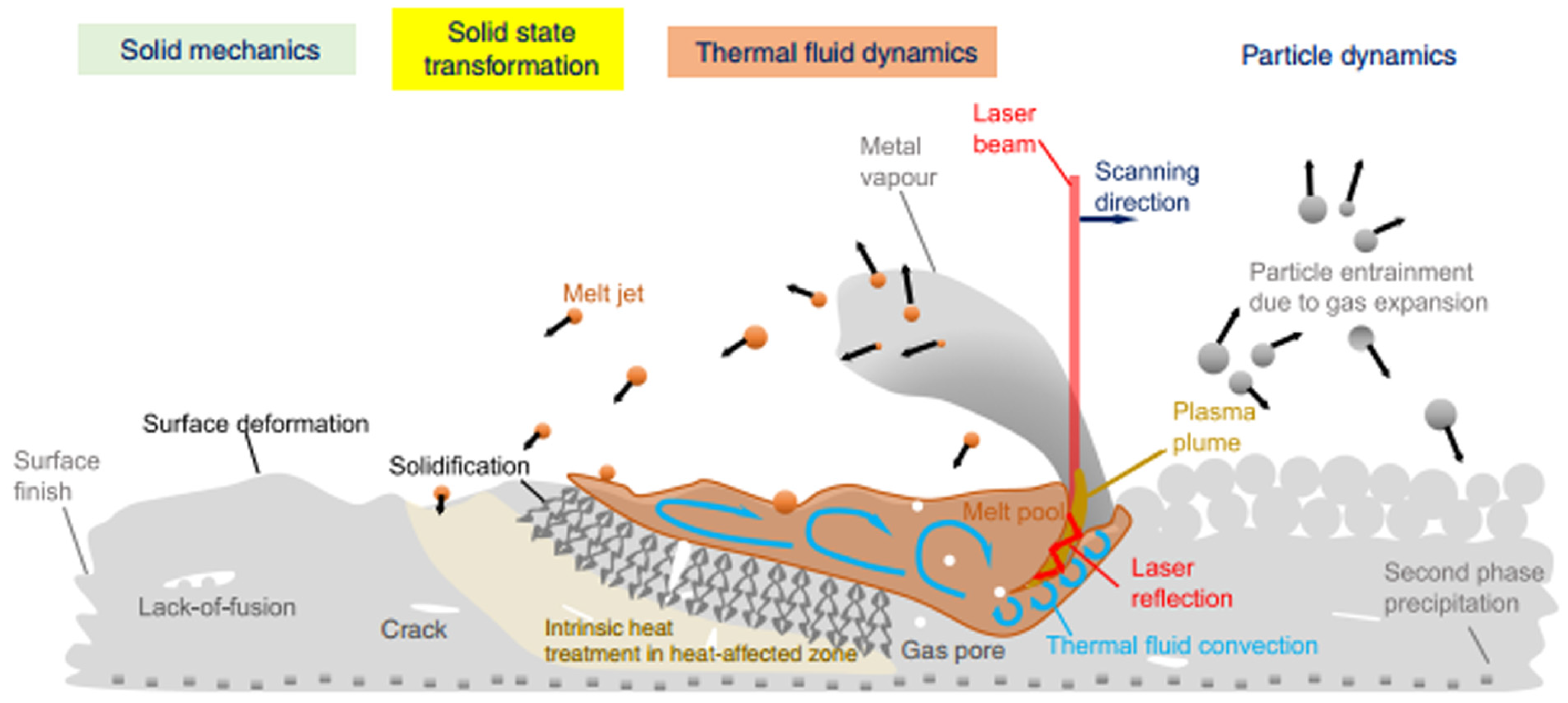
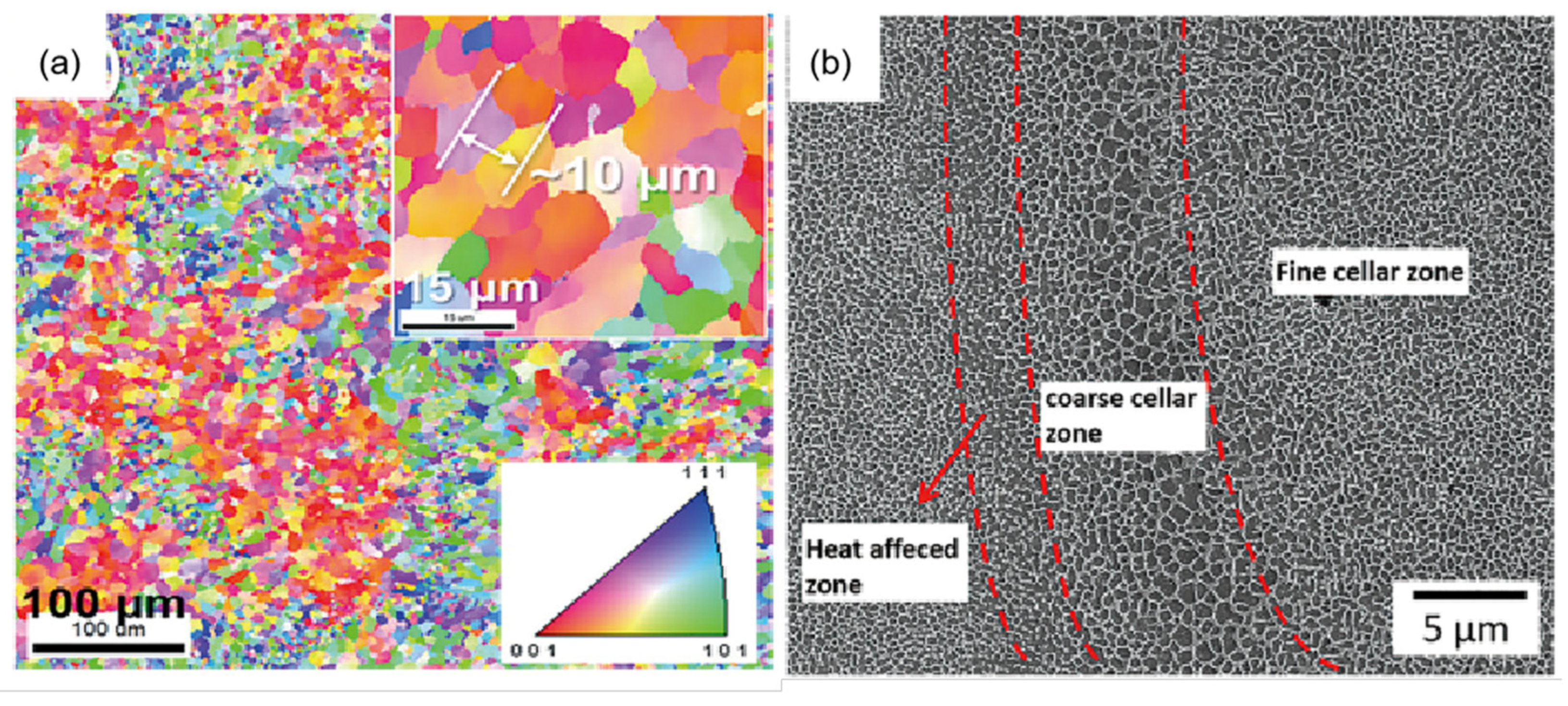

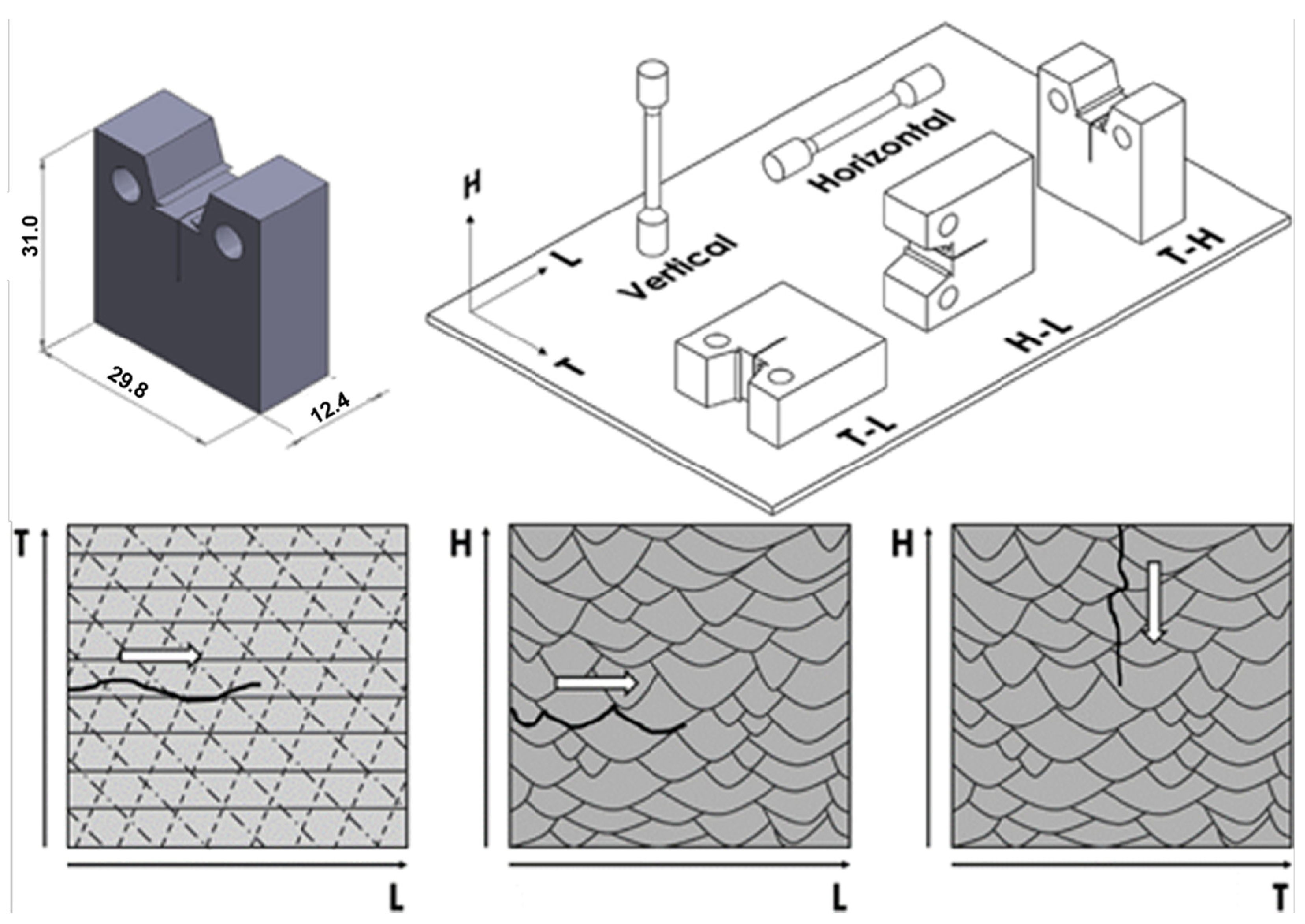

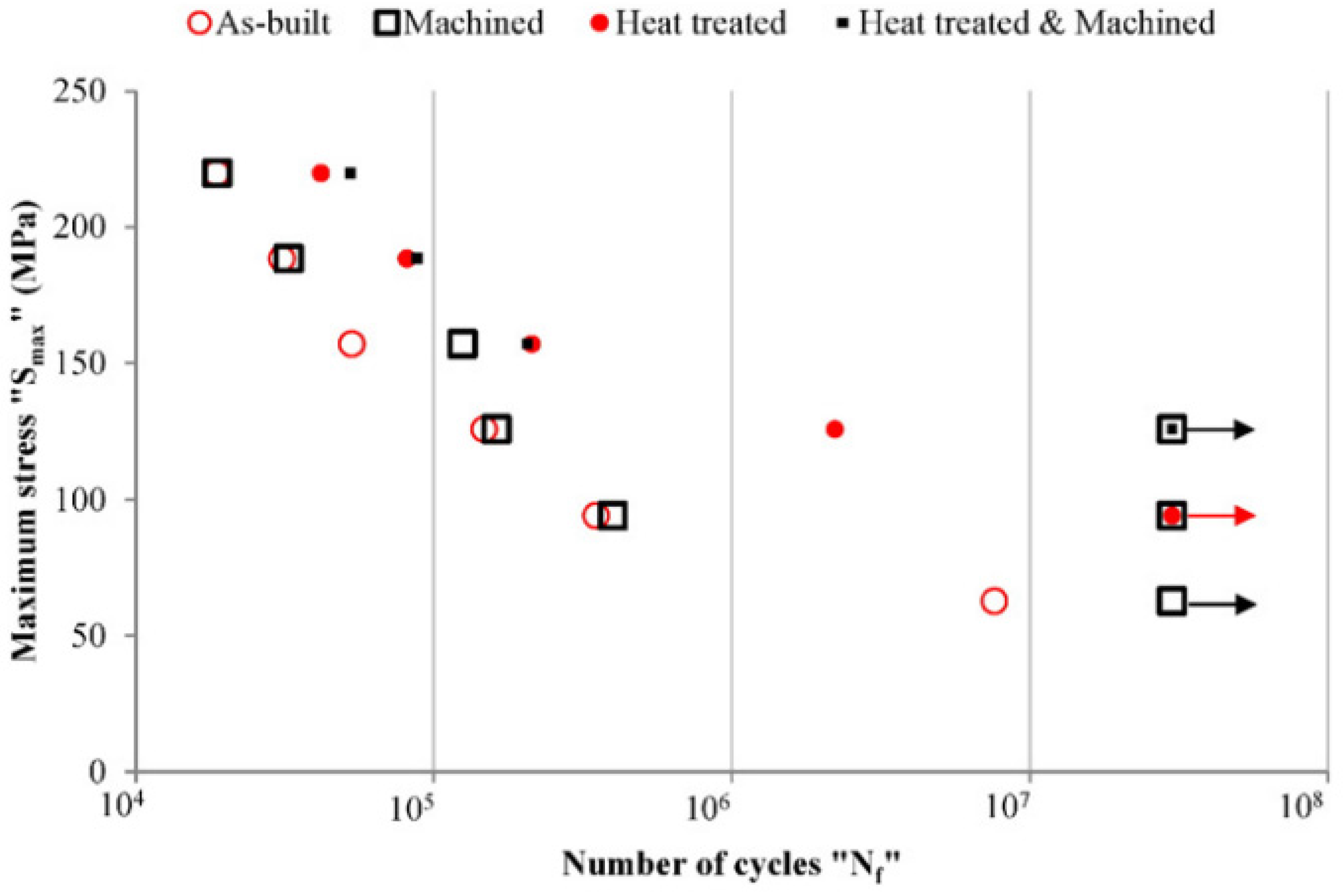
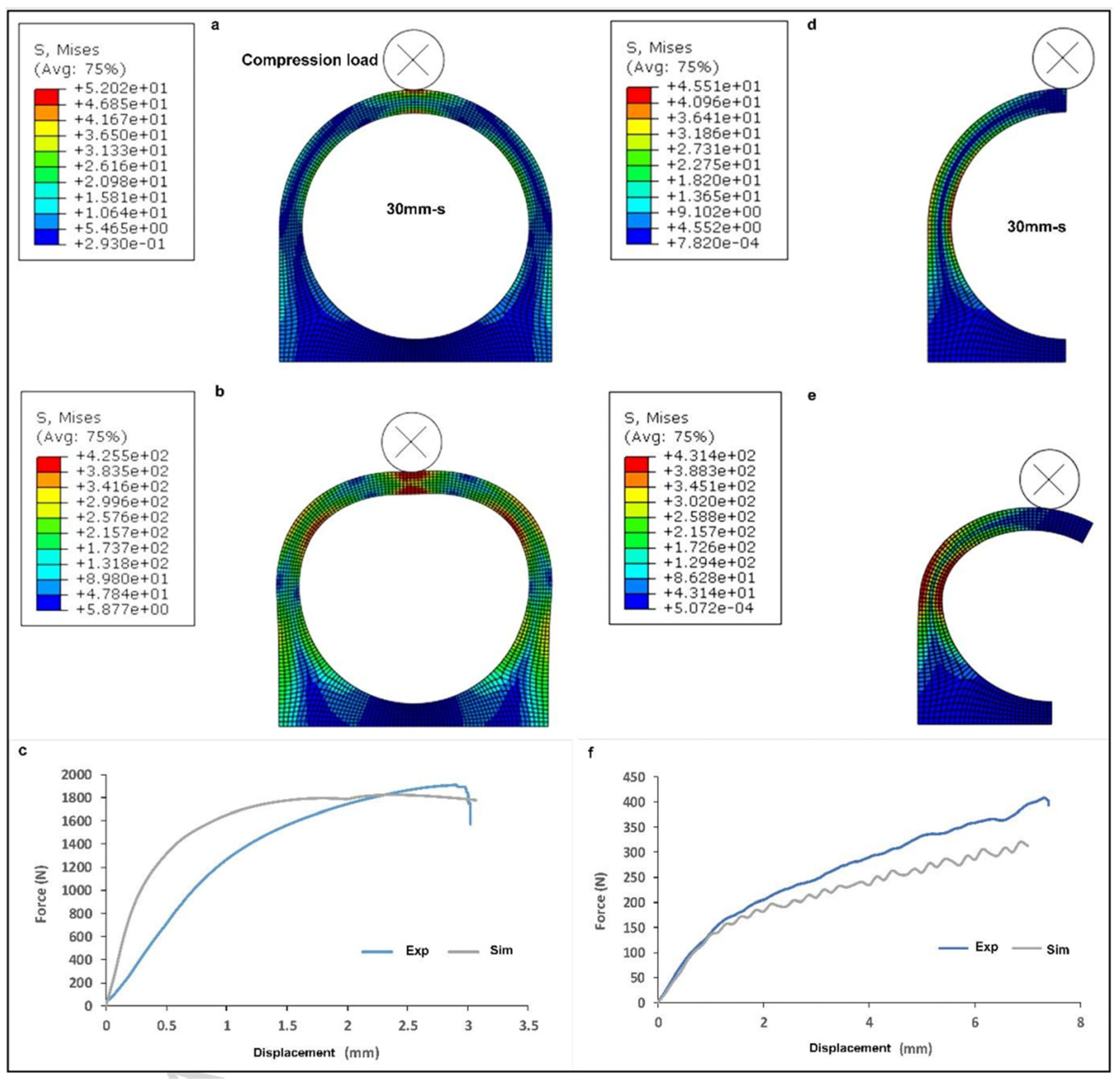
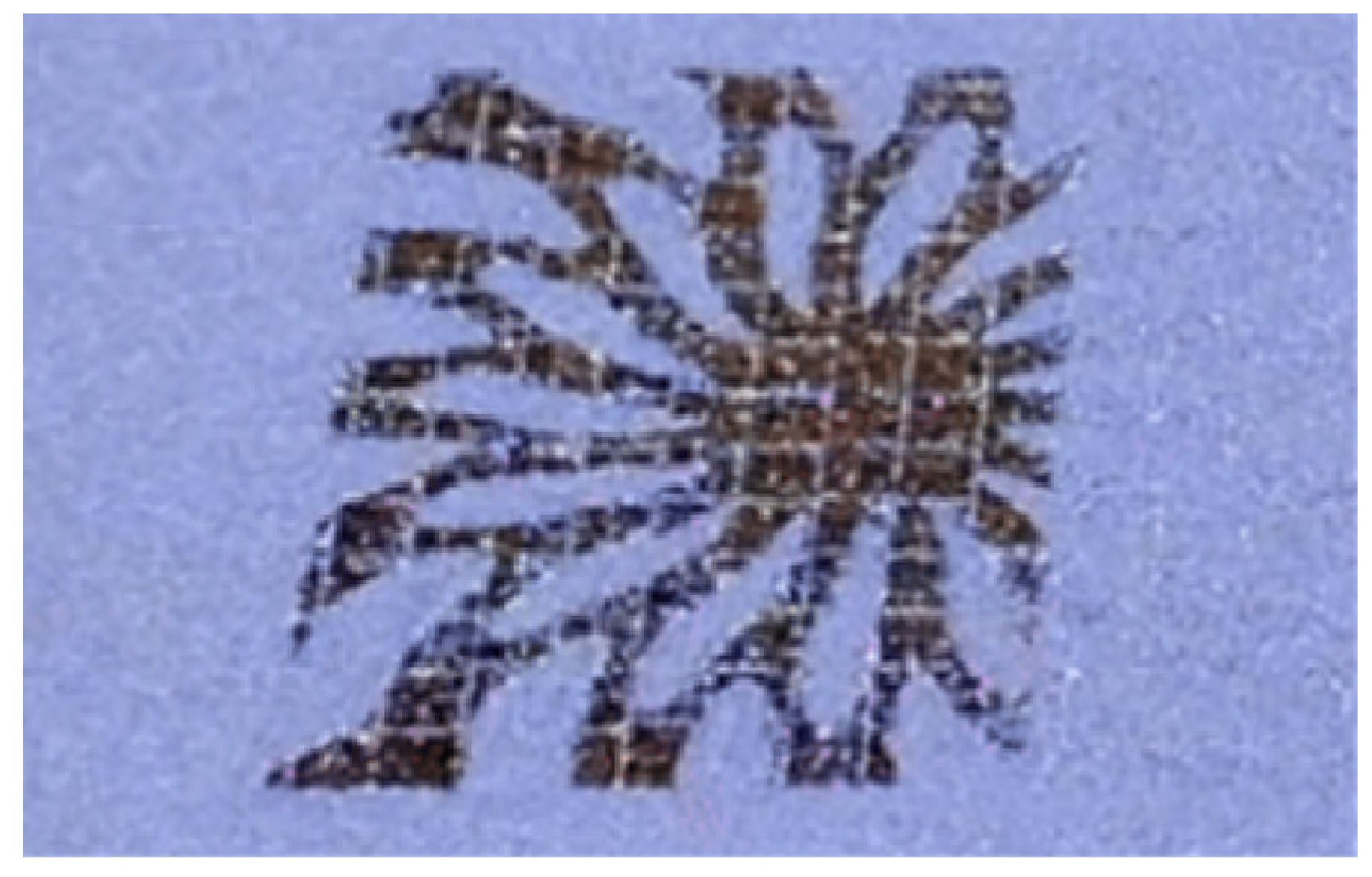
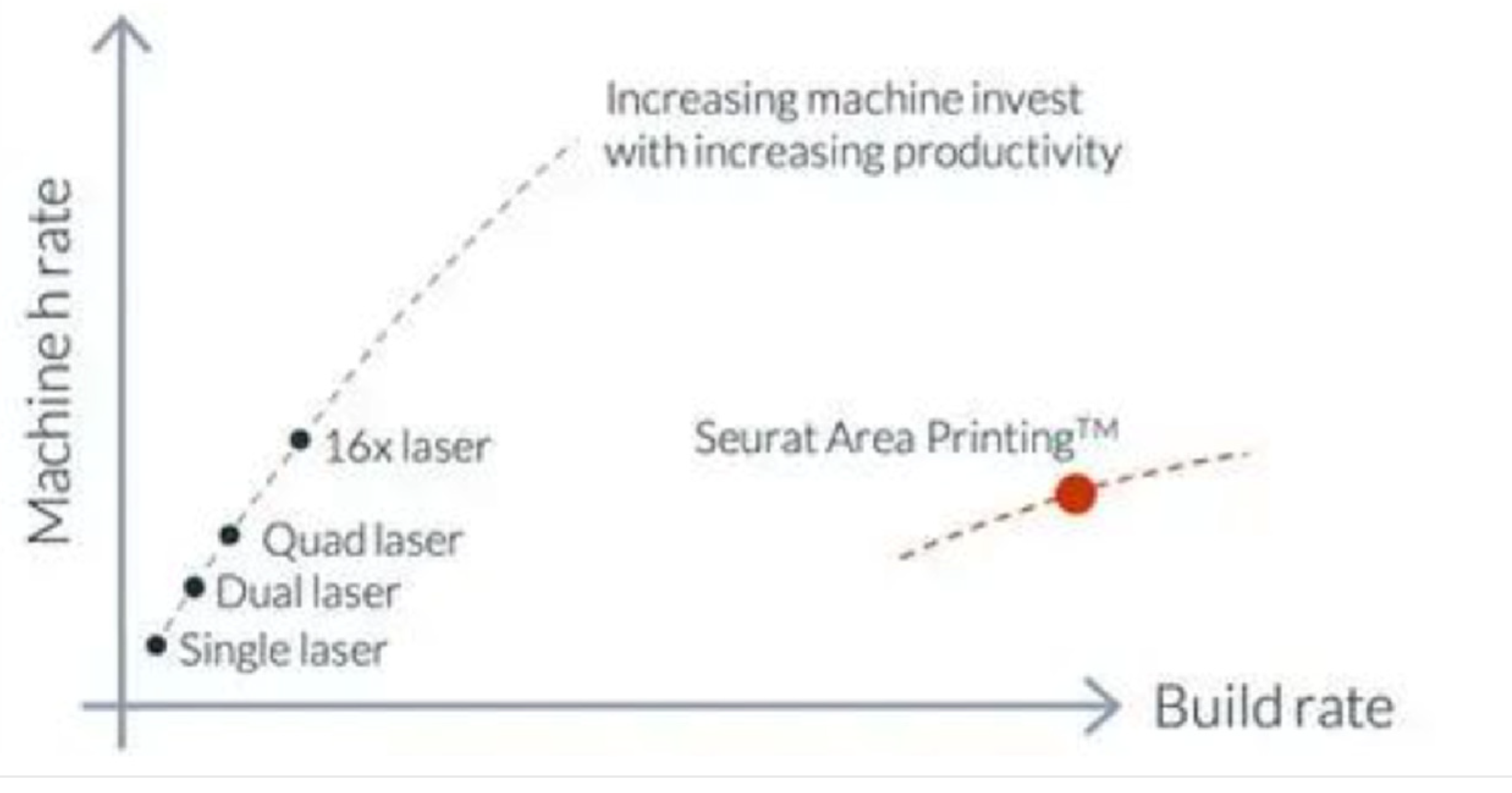
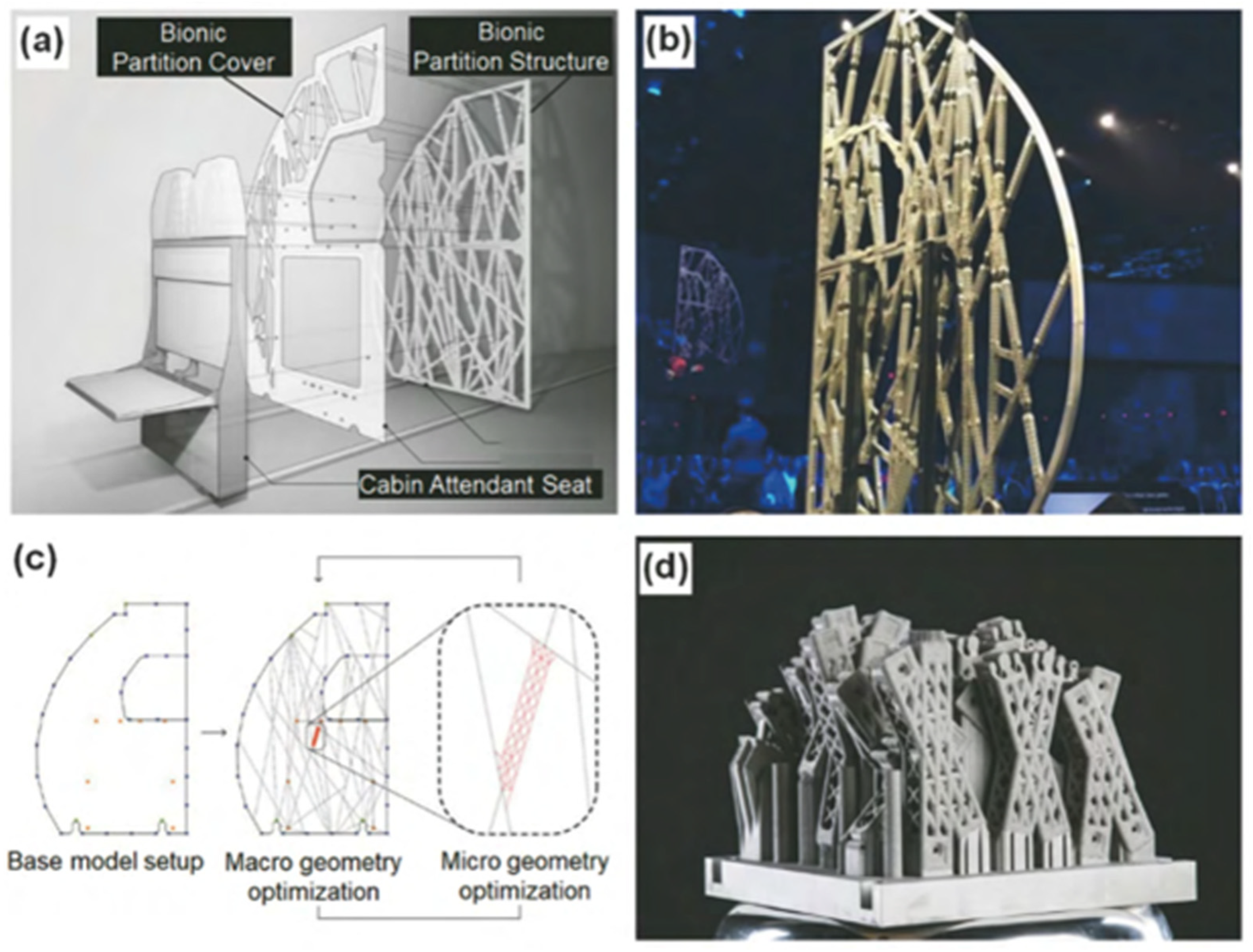

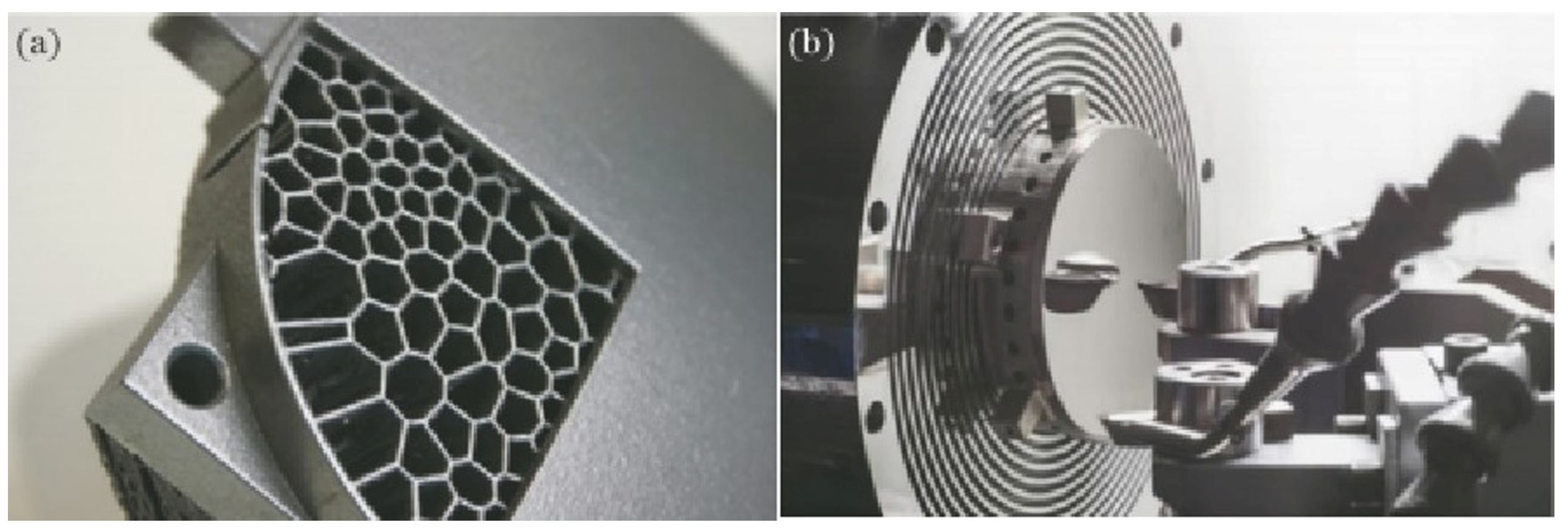
| Materials | Type | Price CNY (USD)/kg |
|---|---|---|
| 2014 | Bar, Panel | 29–42 (4.00–5.80) |
| 2219 | Bar, Panel, Pipe | 24–26.9 (3.31–3.71) |
| 2A12 | Bar, Panel, Pipe | 16–32 (2.21–4.42) |
| 5052 | Bar, Panel, Pipe | 15.8–23 (2.18–3.17) |
| 5005 | Bar, Panel, Pipe | 17–25 (2.35–3.45) |
| 5A06 | Bar, Panel, Pipe | 20–32 (2.76–4.42) |
| 6061 | Wire, Bar, Panel, Pipe | 18–27 (2.48–3.73) |
| 6063 | Bar, Panel, Pipe | 18–35 (2.48–4.83) |
| 7A04 | Wire, Bar, Panel, Pipe | 19–26 (2.62–3.59) |
| 7055 | Panel, Pipe | 42–51 (5.80–7.04) |
| 7075 | Bar, Panel, Pipe | 26–45 (3.59–6.21) |
| ZLD201A | Ignot | 17–26 (2.35–3.59) |
| ZL101 | Ignot | 17–19 (2.35–2.62) |
| ADC6 | Ignot | 23.5 (3.24) |
| Materials | AlSi10Mg | 6061 | 7075 | |||
|---|---|---|---|---|---|---|
| Type | Powder | Ignot | Powder | Ignot | Powder | Ignot |
| Price/CNY (USD) | 100–200 (13.80–27.60) | 20–30 (2.76–4.14) | 700–800 (96.61–110.41) | 19–23 (2.62–3.17) | 400–450 (55.21–62.11) | 25–35 (3.45–4.83) |
Disclaimer/Publisher’s Note: The statements, opinions and data contained in all publications are solely those of the individual author(s) and contributor(s) and not of MDPI and/or the editor(s). MDPI and/or the editor(s) disclaim responsibility for any injury to people or property resulting from any ideas, methods, instructions or products referred to in the content. |
© 2024 by the authors. Licensee MDPI, Basel, Switzerland. This article is an open access article distributed under the terms and conditions of the Creative Commons Attribution (CC BY) license (https://creativecommons.org/licenses/by/4.0/).
Share and Cite
Wang, X.; Zhang, D.; Li, A.; Yi, D.; Li, T. A Review on Traditional Processes and Laser Powder Bed Fusion of Aluminum Alloy Microstructures, Mechanical Properties, Costs, and Applications. Materials 2024, 17, 2553. https://doi.org/10.3390/ma17112553
Wang X, Zhang D, Li A, Yi D, Li T. A Review on Traditional Processes and Laser Powder Bed Fusion of Aluminum Alloy Microstructures, Mechanical Properties, Costs, and Applications. Materials. 2024; 17(11):2553. https://doi.org/10.3390/ma17112553
Chicago/Turabian StyleWang, Xin, Dongyun Zhang, Ang Li, Denghao Yi, and Tianci Li. 2024. "A Review on Traditional Processes and Laser Powder Bed Fusion of Aluminum Alloy Microstructures, Mechanical Properties, Costs, and Applications" Materials 17, no. 11: 2553. https://doi.org/10.3390/ma17112553
APA StyleWang, X., Zhang, D., Li, A., Yi, D., & Li, T. (2024). A Review on Traditional Processes and Laser Powder Bed Fusion of Aluminum Alloy Microstructures, Mechanical Properties, Costs, and Applications. Materials, 17(11), 2553. https://doi.org/10.3390/ma17112553





